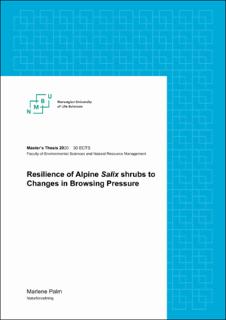| dc.description.abstract | Browsing by large herbivores has the potential to inhibit climate-driven shrub expansion. How resilient shrubs are to a change in herbivory, however, is not fully understood.
In this study, I want to examine how Salix growth and shoot density respond to a change in browsing pressure along an elevational gradient. For fourteen years, the study site has been divided into fenced areas with different sheep densities (0, 25 and 80 sheep per km2). Before and after this period the entire area had a sheep density around 25 sheep per km2. In 2019, three years after the fences were taken down, I measured shoot density, height and stem diameter of Salix shrubs. I compared this data to data sampled in 2010, while the fences were still erect. I expected that the differences in shrub density and growth due to different sheep densities in the enclosures, had already disappeared in 2019.
Shoot density was increasing with elevation in enclosures without sheep in 2010, while it was decreasing in the other enclosures. This difference was still observed in 2019. Shrubs were generally smaller and had thicker stems in 2019 compared to 2010. The differences in height and stem diameter after 8 years with different sheep densities in the enclosures were still present in 2019. Compared to 2010, however, in there were changes in height to stem diameter ratio. In 2010, shrubs in the unbrowsed enclosures had a greater height to stem diameter ratio than shrubs in the other enclosures. In 2019, height to stem diameter ratio was the same for all shrubs, regardless of the sheep density they were exposed to when the fences were erect.
Salix shrubs seemed to quickly adapt their growth pattern to the reintroduction of low sheep density after the enclosures were removed. For shoot density, height and stem diameter, the differences resulting from different sheep densities in the enclosures remained in 2019. This indicates that three seasons with initial low grazing regime are not enough to reverse the changes caused by fourteen years with altered sheep density. | en_US |

